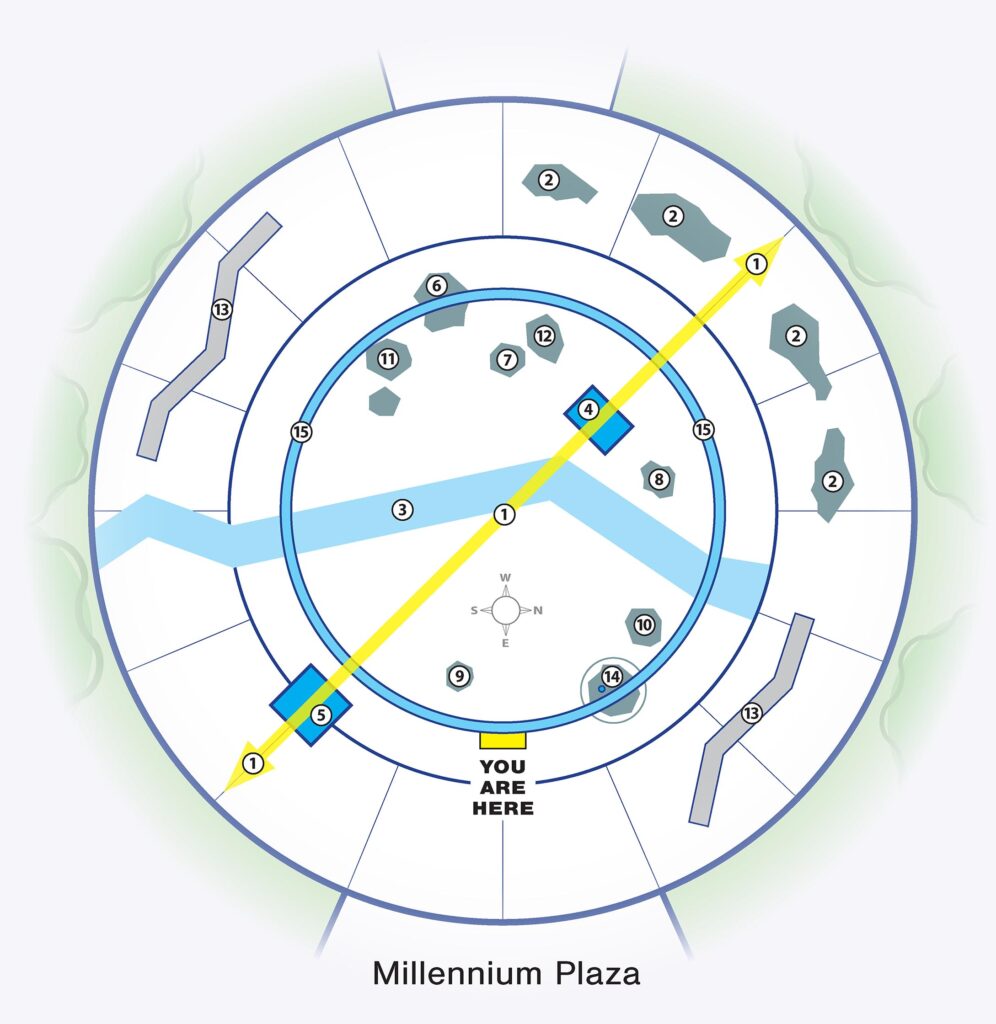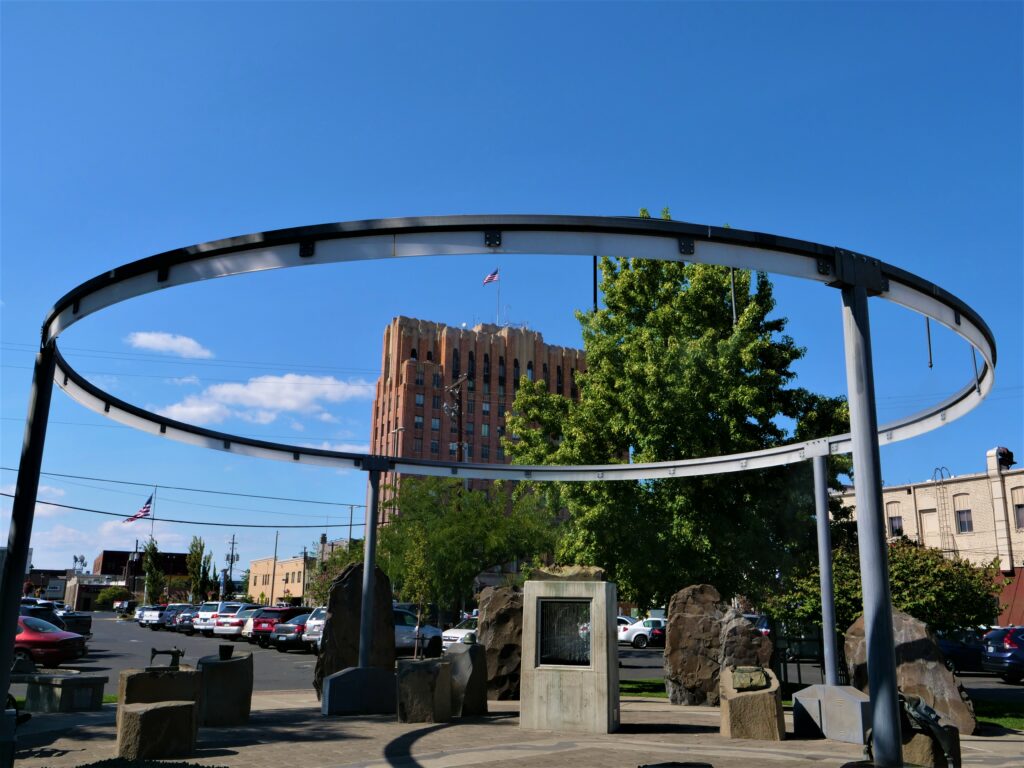Millennium Plaza
A Community Gathering Place
WATER OF LIFE:
The Millennium Plaza of Yakima
This plaza celebrates the importance of water for the people of Yakima. The Yakima River brings life to the valley with vegetation, game, and fruit. Irrigation from the mountains gives abundance to the orchards and fields. People from many places and far away come for the labor and livelihood the land offers.
On the plaza, the four basalt rocks represent the stratum of earth out of which the water flows.
The tank represents the human ability to transform nature into resource.
The bronze sculpture of the mountain is the Nelson Ridge in the Cascade Range, almost exactly 40 miles in line to the west. The plaza is oriented so that the last rays of summer solstice sunset would shine straight through the tank.
The bronze objects on stone columns in the middle of the plaza are casts of tools used for work by people through the ages.
On the ground is inset a representation of the Yakima River as it flows to the Columbia east of the city.
The bronze apple orchard with 110 trees, on the fountain in front along the axis, represents the fruitfulness of the irrigated land. The base of the sculpture replicates the dimensions of the bins commonly used to collect harvested fruit for transportation.
The walls on two sides, like enfolding arms, contain objects and ideas made or offered by area’s artists, members of communities, elders, and teens to help the community navigate through the millennia. These objects and ideas tap into the power and ability among us to redeem the past, to reconcile the present, and to imagine a good future.
The ring of colored light above, inspired by the rhythm and movement of the friendship dance at the powwows of the Yakama people, represents the continuous and ever-changing cycle of connections between people.
In celebrating water, this plaza is the manifest gathering spot that celebrates the coming together of all people.
Wen-ti Tsen, artist
Plaza Map

(Numbers refer to locations on plaza map.)
- The plaza is arranged on an axis in alignment with the summer solstice sunset and the winter solstice sunrise. Concentric circles suggest coming together and continuity.
- Basalt stones represent the earth from which water flows.
- The Yakima River flows through the plaza toward the Columbia River.
- A bubbling water tank represents how water from the Cascade Mountains is transformed by humans.
- An orchard fountain shows the fruitfulness of irrigated land.
- A Yakama berry basket honors the first people of the Yakima Valley.
- An irrigation valve handle represents human ingenuity that brought water to dry lands.
- An apple-picker’s harvest bag honors the people who work in our orchards.
- A short-handled hoe honors the people who work on our farms.
- A saddle recognizes the horse, bred and raised by Plateau Indians and essential to the development of our valley.
- A sewing machine honors the work of pioneer women.
- A GI helmet honors the men and women who served in the US military.
- Displays of artwork, artifacts, history, and ideas represent the diverse individuals and communities of the Yakima Valley.
- A fountain represents the spirit of life-giving water.
- A ring of dancing light encircles this plaza, acknowledging the unity of all people.
A Project of Allied Arts Council of Yakima Valley
In 1999, the National Endowment for the Arts announced Artists & Communities: America Creates for the Millennium, a national initiative to celebrate the year 2000. The NEA invited arts organizations from throughout the United States to propose community art projects, and winning projects were paired with selected artists from across the country. The winner of Washington’s Millennium Arts Project Competition was the Allied Arts Council of Yakima Valley, and the arts organization and its director Elizabeth Herres Miller chose artist Wen-ti Tsen of Boston to realize their vision of a downtown plaza celebrating the Yakima Valley and its people.
Wen-ti Tsen lived and worked in the Yakima Valley for 18 months and gained a personal connection with its people and communities, listening and generating real dialogue about art, creativity, and the issues we faced at the turning of the Millennium. He used this experience to facilitate the creation of images, words, and objects in the plaza design. Yakima Valley individuals, institutions, and businesses generously stepped forward to support the Millennium Arts Plaza through their contributions of time, ideas, and financial support. In 2003, the plaza was completed and dedicated as a lasting tribute to the Millennium.
Allied Arts Council of Yakima Valley was established in 1962 “to encourage, promote and coordinate the practice and appreciation of all the arts among the people of Central Washington.” It was Washington State’s second oldest arts council. Located in a converted apple warehouse in West Yakima’s Gilbert Park, the Allied Arts Center offered a theatre, gallery, classrooms, library, and meeting rooms that served thousands of children, adults, families, and organizations each year, all made possible through the generous support of individuals and businesses in Yakima and the Valley. In 2015, the Allied Arts Center was demolished after structural inspections revealed irreparable damage to the old warehouse building, and more than 50 years of service to the community came to an end. This arts plaza survives as a time capsule of the turning of the 21st century and a memorial to the Allied Arts Council of the Yakima Valley.

